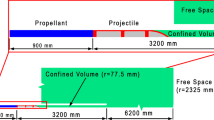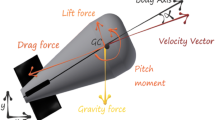Abstract
Precision-guided projectiles (PGPs) typically deployed in smart munitions are operated and guided by highly sophisticated embedded electronic systems (EES). These PGPs are subjected to severe shock loads resulting from the ignition of the propellant during their launch. These shock loads, which are typically characterised by high intensity, short duration and wave reflections at varied frequencies, often lead to the failure of the EES. It is the objective of this work to conduct a comprehensive multiphysics analysis of the launch process of PGPs accounting for coupling and interaction effects between the different media (propellant, PGP, confined volume and free space). Specifically, we investigated the entire launch process that include the ignition of the propellant to observe local and global features of the setback, set forward pressure and acceleration histories using explicit axisymmetric Lagrangian–Eulerian finite element simulations. In this work, we also examine the severity and frequency of the reflected waves as well as the springback of the PGPs resulting from these local oscillations as they exit the muzzle. In addition, the flight state transition due to muzzle exit in terms of pressure and flow velocity is also discussed. Our results reveal the complex phenomena associated with the dynamic response of the PGPs and pressurization process resulting from the ignition of propellant during launch that are characterized by high oscillatory pressure profiles and projectile springback.




















Similar content being viewed by others
Abbreviations
- A:
-
Internal cross-sectional barrel area
- B :
-
Hardening constant
- b 0 :
-
Burn rate constant
- \( \dot{b} \) :
-
Burn-rate
- C:
-
Total propellant mass
- C 0 :
-
Strain rate constant
- c :
-
Growth reaction exponent
- c p :
-
Propellant specific heat
- D :
-
Reaction constant
- Dw :
-
Propellant web size
- Eproj :
-
Projectile kinetic energy
- Eprop :
-
Propellant kinetic energy
- e g :
-
Propellant specific energy
- F:
-
Web fraction
- G :
-
Reaction growth constant
- G p :
-
Shear modulus for projectile
- K g :
-
Bulk modulus for propellant
- K p :
-
Bulk modulus for projectile
- l:
-
Effective chamber length
- m :
-
Thermal softening exponent
- m s (t 0):
-
Initial solid propellant mass
- m s (t):
-
Solid propellant mass
- n :
-
Burn rate exponent
- n 0 :
-
Hardening exponent
- P:
-
Base pressure
- P 1 :
-
Average pressure
- P c :
-
Base pressure at burnout
- P g :
-
Pressure of reaction product
- T m :
-
Material melting temperature
- U:
-
Effective chamber volume
- V(t):
-
Projectile velocity at time t
- W(t):
-
Work done on the system
- x :
-
Projectile travel
- x c :
-
Projectile location at burnout
- β :
-
Burn rate constant
- Γ:
-
Specific capacity ratio
- θ :
-
Grain shape factor
- λ :
-
Force constant of propellant
- ρ g :
-
Gas density of reactive products
- ρ p :
-
Projectile density
- ρ s :
-
Solid density of propellant
- σ y :
-
Yield strength
- \( \dot{\phi } \) :
-
Reaction rate
- ϕ(t):
-
Reaction ratio
References
ANSYS Autodyn Material manual, Chapter 9
Baer, P., Frankle, J.: The Simulation of Interior Ballistic Performance of Guns by Digital Computer Program, Rep. BRL-1183, Aberdeen (1962)
Berman, M., D. Hopkins, D., Powers, B., Minnicino, M.: Numerical and Experimental Modeling of the Transition from Transient to Quasi-static Loading of Printed Wiring Assemblies, 2003 SEM Annu. Confer. Expo. Exp. Appl. Mech., Charlotte (2003)
Carlucci, D. E., Cordes, J., Hahn, J., Frydman, A.: Electronics and the gun environment. Ferroelectrics, 342, 193–204 (2006a). doi:10.1080/00150190600946377
Carlucci, D., Cordes, J., Morris, S., Gast, R.: Muzzle Exit (Set Forward) Effects on Projectile Dynamics, Rep. ARAET-TR-06003, Picatinny (2006b)
Carlucci, D., Jacobson, S.: Ballistics Theory and Design of Guns and Ammunition. CRC Press, New York (2007). ISBN 978-1-42-006618-0
Chakka, V., Tribia, M.B., O’Toole, B., Sridharala, S., Ladkany, S., Chowdhury, M.: Modeling and reduction of shocks on electronic components within a projectile. Int. J. Impact Eng. 35, 1326–1338 (2008). doi:10.1016/j.ijimpeng.2007.07.005
Chao, N.H., Cordes, J.A., Carrlucci, D., DeAngelis, M.E., Lee, J.: The use of potting materials for electronic-packaging survivability in smart munitions. J. Electron. Package 133, 1–10 (2011)
Chowdhury, M. R., Frydman, A., Cordes, J., Reindhardt, L., Carlucci, D.: 3-D finite-element gun lunch simulation of a surrogate Excalibur 155 mm guided artillery projectile-modeling capabilities and its implications, 22nd Int. Symp. Ballist., Vancouver, pp. 259–267 (2005)
Cordes, J., Vega, J., Carlucci, D., Chaplin, R.C.: Design accelerations for the army’s Excalibur projectile, Rep. ARAET-TR-05008, Maryland (2005a)
Cordes, J.A., Vega, J., Carlucci, D., Chaplin, R. C.: Structural loading statistics of live gun firings for the army’s Excalibur projectile, Rep. ARAET-TR-05005, Picatinny (2005b)
Corner, J.: Theory of Interior Ballistics. Wiley, New York (1950)
Gough, P. S.: The XNOVAKTC Code, Rep. BRL-CR-627, Maryland (1990)
Hollis, M. S. L.: Use of finite-element stress analysis in the design of a tank-cannon-launched training projectile, Rep. ARL-MR-149, Aberdeen (1994)
Johnson, G. R., Cook, W. H.: A Constitutive Model and Data for Metals Subjected to Large Strains, High Strain Rates and High Temperature, 7th Int. Symp. Ballist., 21, pp. 541–547 (1983)
Laughlin, K. D.: Characterization of the parameters that affect projectile balloting using finite element analysis, Ph.D. Dissertation, University of Oklahoma (2008)
Lee, R.: Instrumented Projectile Firings in a 155-mm Regenerative Liquid Propellant Gun (RLPG) System, Rep. ARFSD-TR-93093, Picatinny (1993)
Miura, H., Matsuo, A., Nakamura, Y.: numerical prediction of interior ballistics performance of projectile accelerator using granular or tubular solid propellant. Propellants, Explos., Pyrotech. 38, 204–213 (2013). doi:10.1002/prep.201200084
Nusca, M., Horst, A.: Progress in Modeling Ignition in a Solid Propellant Charge for Telescoped Ammunition, Rep. ARL-TR-3673, Aberdeen (2005)
Nuscsa, M. J., Horst, A. W., Newill, J. F.: Multidimensional, Two-Phase Simulations of Notional Telescoped Ammunition Propelling Charge, Rep. ATL-TR-3306, Aberdeen (2004)
Peregino II, P. J., Bukowski, E.: Projectile-Bore Instrumentation for Characterization of In-Bore Environments, 23rd Int. Symp. Ballist., Tarragona, pp. 481–488 (2007)
Ritter, J. J., Homan, B. E., Thalman, W.: Dynamic Pressure Testing of a 155-mm Howitzer Ballistic Window Using a Closed Bomb Vessel, Rep. ARL-TR-5266, Picatinny (2010)
Ruth, C., Horst, A.: Detailed Characterization of Hypervelocity Firings in a Long 120-mm Gun, Rep. BRL-TR-3190, Aberdeen (1991)
Smestad, E., Moxnes, J., Odegardstuen, G.: Modelling of Deflagration, Establishing Material Data into ANSYS AUTODYN’s Powder Burn Model, Int. Annu. Conf.—Fraunhofer Inst. Chem. Techn. (2011)
Sorenson, B. R.: Design and analysis of Kinetic energy projectile using Finite-Element Optimization, Rep. BRL-TR-3289, Aberdeen (1991)
Tompkins, R. E., White, K. J., Oberle, W. F., Juhasz, A. A.: Traveling charge gun firings using very high burning rate propellants, Rep. BRL-TR-2970, Aberdeen (1988)
Acknowledgments
The authors would like to thank the Anonymous Sponsor for the financial support of this study. We also thank the Natural Sciences and Engineering Research Council of Canada and the Discovery Accelerated Supplement for their kind support. Finally, we wish to thank Drs. Missy Ji and Chris Quan of ANSYS Inc. for helpful discussions concerning the modelling of propellant combustion.
Author information
Authors and Affiliations
Corresponding author
Rights and permissions
About this article
Cite this article
Yin, X.W., Verberne, P. & Meguid, S.A. Multiphysics modelling of the coupled behaviour of precision-guided projectiles subjected to intense shock loads. Int J Mech Mater Des 10, 439–450 (2014). https://doi.org/10.1007/s10999-014-9255-0
Received:
Accepted:
Published:
Issue Date:
DOI: https://doi.org/10.1007/s10999-014-9255-0




